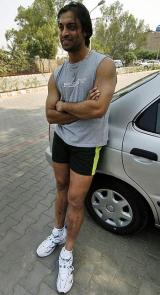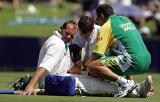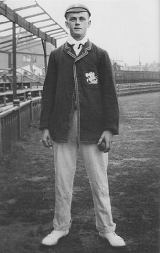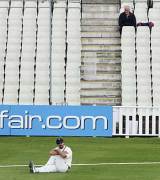Call back the medics
Another batch of cricketers who have kept the medical profession in gainful employment
Martin Williamson and Andrew McGlashan
04-Jul-2006
Last week we featured a Cricinfo XI of players whose careers have been synonymous with doctors' bulletins. We got a considerable amount of feedback, so inspired by your suggestions, here is a second XI of cricketers who have kept the medical profession in gainful employment.
If you're outraged by our selections, let us
know.
|
|

|
The Rawalpindi Express has come off the rails so many times it is hard to keep track of which part of his body is falling apart. Most Pakistan squads are followed by a fitness update on Shoaib's ribs, knees or ankles and the current tour of England has begun in familiar fashion with him withdrawing through a recurrence of a stress fracture to his ankle. The problem with Shoaib is that the paths of his injuries - and recuperation - often take unusual courses. It has not been unknown for him to pull out of a tour, then be found rocking up for a lucrative celebrity match a few days later. He would do well to buy a home in Australia given the amount of trips he has made there to visit specialists.
Martin Crowe
One of New Zealand's greatest batsmen was also one with the weakest knees, and he tottered and limped his way through the latter stages of his career. He had already had to battle to overcome more than his fair share of injuries, including a broken shin, back trouble and torn hamstrings. In the 1990s, New Zealand squad announcements were usually made by the team doctor rather than the selectors, so prone was he to injury. In the end a chronically arthritic right knee, the result of an accident when he was a schoolboy, forced him from the game at 33, an age other great batsmen were at their peak.
One of New Zealand's greatest batsmen was also one with the weakest knees, and he tottered and limped his way through the latter stages of his career. He had already had to battle to overcome more than his fair share of injuries, including a broken shin, back trouble and torn hamstrings. In the 1990s, New Zealand squad announcements were usually made by the team doctor rather than the selectors, so prone was he to injury. In the end a chronically arthritic right knee, the result of an accident when he was a schoolboy, forced him from the game at 33, an age other great batsmen were at their peak.
Dean Headley
Another promising career cut cruelly short by injury, just as it looked like England had found a strike bowler. His match-winning spell at Melbourne should have been the catalyst for a long stay in the Test side but since his early days at Middlesex, Headley had been an injury waiting to happen. After the 1996-97 A tour of Australia he spent the first part of the following season in traction to try and sort out a long-standing hip problem. Headley believes that had an effect further down the line, in 1997 he said: "But I believe the back problems I've had recently can be linked to the traction I was put under when I returned from down under. I've certainly never had them before." His back gave way permanently during the 1999-00 tour of South Africa and after missing the entire 2000 season he finally conceded defeat and retired.
Another promising career cut cruelly short by injury, just as it looked like England had found a strike bowler. His match-winning spell at Melbourne should have been the catalyst for a long stay in the Test side but since his early days at Middlesex, Headley had been an injury waiting to happen. After the 1996-97 A tour of Australia he spent the first part of the following season in traction to try and sort out a long-standing hip problem. Headley believes that had an effect further down the line, in 1997 he said: "But I believe the back problems I've had recently can be linked to the traction I was put under when I returned from down under. I've certainly never had them before." His back gave way permanently during the 1999-00 tour of South Africa and after missing the entire 2000 season he finally conceded defeat and retired.
|
|

|
South Africa's version of the wall has started to show a few cracks recently. For most of last season he was hampered by tennis elbow, but such is his importance to the South African cause, surgery was delayed until the very last moment so that he could take on Australia. He will now miss the tour of Sri Lanka and his injury has clearly hampered his naturally free-flowing strokeplay meaning he has been reduced to occupying the crease for even longer. However, to his credit, he continued to churn out the runs and perform his fair share of bowling duties. Who knows, maybe surgery will revitalise Kallis and he'll return as a daring and dashing stroke-maker who'll destroy attacks. Or maybe not.
Angus Fraser
There were many bowlers who should never have got nowhere near an England cap during the 80s and 90s, which makes the fact that Fraser only managed 46 Tests even more of a travesty. Although this was often down to strange selection policies, a career-threatening hip injury picked up on the 1990-91 tour of Australia played a huge part. It ruled him out of international cricket for two years and there was a fear he would never play again. When he did return his pace had been reduced. However, that didn't reduce his effectiveness, especially in the Caribbean where he had first made his name in 1989-90. He twice took eight-wicket hauls, at Barbados in 1994 and Trinidad in 1998. At least his aching body gave him another excuse to look knackered during every spell he bowled.
There were many bowlers who should never have got nowhere near an England cap during the 80s and 90s, which makes the fact that Fraser only managed 46 Tests even more of a travesty. Although this was often down to strange selection policies, a career-threatening hip injury picked up on the 1990-91 tour of Australia played a huge part. It ruled him out of international cricket for two years and there was a fear he would never play again. When he did return his pace had been reduced. However, that didn't reduce his effectiveness, especially in the Caribbean where he had first made his name in 1989-90. He twice took eight-wicket hauls, at Barbados in 1994 and Trinidad in 1998. At least his aching body gave him another excuse to look knackered during every spell he bowled.
Chris Old
He had a lovely fast bowler's action and was a natural athlete, but when England really needed Old, he was often to be found on the physio's bench, usually suffering from problems with his back or his legs. Once he sneezed on the morning of a match and damaged a rib. In the end, knee problems forced him to retire. As Frank Keating once wrote of Old: "Ask that engaging hypochondriac how he is keeping and the answer, as ever, takes a full half-hour." In 1993, an old England side took on their Australian contemporaries in a re-run of the Centenary Test for charity. Few eyebrows were raised when Old hobbled off with a dodgy knee.
He had a lovely fast bowler's action and was a natural athlete, but when England really needed Old, he was often to be found on the physio's bench, usually suffering from problems with his back or his legs. Once he sneezed on the morning of a match and damaged a rib. In the end, knee problems forced him to retire. As Frank Keating once wrote of Old: "Ask that engaging hypochondriac how he is keeping and the answer, as ever, takes a full half-hour." In 1993, an old England side took on their Australian contemporaries in a re-run of the Centenary Test for charity. Few eyebrows were raised when Old hobbled off with a dodgy knee.
|
|

|
Blythe was a key member of a great Kent side in the decade immediately before the Great War, but despite this he played only 19 Tests. For once, the whims of the selectors were not to blame, but Blythe's inability to cope with the pressure of Test cricket was. He was an epileptic, and the burden that came with playing for England was too much, so much so that Kent issued a release during the 1909 Ashes series stating that Blythe suffered from a disorder "caused by playing in a match and which lasts for a week afterwards". Despite this, he was one of the first to enlist on the outbreak of war in 1914. He was killed on the Western Front in 1917.
Jeff Thomson
Thommo was a hard man, as befitted someone who kept fit by running down wild pigs in the outback, and one of the fastest bowlers of all time (he was measured at 99mph after his injury). His Test debut was unimpressive, in no small part because he had a broken toe which he decided the selectors need not know about. But from 1974 to 1976 he terrorised batsmen the world over, until a shoulder injury sustained in an on-field collision with Alan Turner at Adelaide meant that he never recaptured that raw pace in anything other than brief spells. "Andy Roberts was fast, Michael Holding a yard faster, and Thommo was three yards faster than Holding," noted Greg Chappell. "His shoulder injury just made him human."
Thommo was a hard man, as befitted someone who kept fit by running down wild pigs in the outback, and one of the fastest bowlers of all time (he was measured at 99mph after his injury). His Test debut was unimpressive, in no small part because he had a broken toe which he decided the selectors need not know about. But from 1974 to 1976 he terrorised batsmen the world over, until a shoulder injury sustained in an on-field collision with Alan Turner at Adelaide meant that he never recaptured that raw pace in anything other than brief spells. "Andy Roberts was fast, Michael Holding a yard faster, and Thommo was three yards faster than Holding," noted Greg Chappell. "His shoulder injury just made him human."
Don Bradman
Although the greatest cricketer of all time, Bradman was not the most robust physical specimen. While the 1934 tour to England was a success for both him and the team ("he'd bat in a wheelchair if necessary," team-mate Bill O'Reilly noted) he was unwell for much of the summer, and reports in newspapers hinted that he was suffering from heart trouble. He lost weight from his already trim frame, and he even missed a number of tour matches in a bid to regain fitness. At the end of the tour he collapsed and a surgeon removed a badly-inflamed appendix which had been at the root of his troubles. But his condition worsened (this was before antibiotics could cure the infections resulting from the operation) and rumours even abounded that he had died. Neville Cardus was asked to write an obituary for The Guardian and King George V requested he be kept informed. Bradman's wife set sail from Australia but few believed her husband would be alive by the time her ship arrived. He rallied, but his recovery was slow and it was a year before he picked up a bat in anger again.
Although the greatest cricketer of all time, Bradman was not the most robust physical specimen. While the 1934 tour to England was a success for both him and the team ("he'd bat in a wheelchair if necessary," team-mate Bill O'Reilly noted) he was unwell for much of the summer, and reports in newspapers hinted that he was suffering from heart trouble. He lost weight from his already trim frame, and he even missed a number of tour matches in a bid to regain fitness. At the end of the tour he collapsed and a surgeon removed a badly-inflamed appendix which had been at the root of his troubles. But his condition worsened (this was before antibiotics could cure the infections resulting from the operation) and rumours even abounded that he had died. Neville Cardus was asked to write an obituary for The Guardian and King George V requested he be kept informed. Bradman's wife set sail from Australia but few believed her husband would be alive by the time her ship arrived. He rallied, but his recovery was slow and it was a year before he picked up a bat in anger again.
Lawrence Rowe
Rowe had the world at his feet when he cracked a double hundred and a hundred on debut, and after three series he averaged over 70. His troubles started when he signed for Derbyshire in 1974, and was soon plagued by hayfever and headaches. He made runs, but was far from happy. He was sent home from the 1974-75 tour of India with eye trouble just as Clive Lloyd's great West Indies side was taking shape, and although he forced his way back into the reckoning, when he returned to England in 1976 his problems resurfaced. It turned out that he had an allergy to grass, a rather unfortunate affliction for a cricketer. He was subsequently found to have teryginum, a disease involving vision-blurring growths. Remedial surgery damaged his eyes, and contact lenses caused his eyes to water. He soldiered on, but was angry and frustrated that he was not the player he once was. That frustration was partly responsible for his decision to lead a rebel West Indies tour to South Africa in 1983.
Rowe had the world at his feet when he cracked a double hundred and a hundred on debut, and after three series he averaged over 70. His troubles started when he signed for Derbyshire in 1974, and was soon plagued by hayfever and headaches. He made runs, but was far from happy. He was sent home from the 1974-75 tour of India with eye trouble just as Clive Lloyd's great West Indies side was taking shape, and although he forced his way back into the reckoning, when he returned to England in 1976 his problems resurfaced. It turned out that he had an allergy to grass, a rather unfortunate affliction for a cricketer. He was subsequently found to have teryginum, a disease involving vision-blurring growths. Remedial surgery damaged his eyes, and contact lenses caused his eyes to water. He soldiered on, but was angry and frustrated that he was not the player he once was. That frustration was partly responsible for his decision to lead a rebel West Indies tour to South Africa in 1983.
|
|

|
The one series where Gillespie probably wishes he had picked up an injury - the 2005 Ashes - was actually one of the few tours he remained fit for the duration. His career, has been dogged by a series of problems to his legs, back, feet, ribs...we could go on. One of the most serious was caused by the horrific collision with Steve Waugh on the Kandy outfield in 1998-99, which left Gillespie with a broken leg and out of the game for nearly a year. He fought back to fitness and full pace, but was always prone to breaking down at any moment and often needed patching-up midway through a match to keep him going. He probably stretches more than any other player during play, just to make sure his body will keep going for a little while longer.
Martin Williamson is managing editor of Cricinfo and Andrew McGlashan is editorial assistant